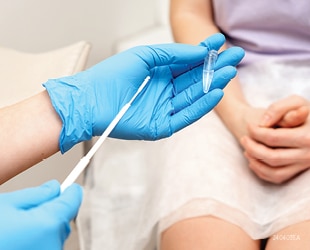HPV Testing for Cervical Cancer Found Effective at Longer Intervals
Less frequent HPV tests detect precancerous lesions of the cervix just as well as more frequent Pap smears, which could help achieve The goal of eliminating the cancer.

When it comes to detecting precancerous lesions of the cervix, less frequent testing for the human papillomavirus (HPV) is just as effective as more frequent cytology screening, such as Pap smears, at even longer than the recommended intervals, according to the results of a study published in Cancer Epidemiology, Biomarkers & Prevention, a journal of the American Association for Cancer Research.
National guidelines recommend that women get a cytology screen, such as a Pap smear, every three years, an HPV screen every five years, or a combination of the two every five years.
A study based on eight to 14 years of testing programs in Canada indicated that one or two negative HPV tests over eight years were at least as effective in detecting precancerous lesions as one or two negative Pap smears over three years.
“HPV screening performs better than cytology by detecting more precancer earlier, which can then be treated earlier,” said Anna Gottschlich, PhD, MPH, assistant professor at Wayne State School of Medicine and the Barbara Ann Karmanos Cancer Institute and corresponding author of the study. “We saw that in our study population, even those who had only one negative HPV test were at very low risk for the development of cervical precancer for many years after the negative test.”
Because of the availability of both HPV screening and effective vaccines against HPV, the World Health Organization (WHO) has set a goal of eliminating cervical cancer worldwide by 2030, defined as reducing new cases to a level of four or fewer per 100,000 women or people with a cervix. In the United States, the incidence of cervical cancer is currently estimated by the National Cancer Institute at 7.6 cases per 100,000.
Healthcare systems worldwide are shifting from conventional cervical cancer screening methods like cytology, or the Pap smear, to HPV-based screening because HPV-based screening has a higher sensitivity to detect precancerous lesions, Dr. Gottschlich said.
“However, some have expressed concern that the longer interval between HPV screens may increase the risk for the development of cervical cancer,” she said. “These findings should provide assurance that the five-year interval recommended for HPV screening is even safer than the three-year interval for cytology screening.”
Examining Screening Intervals
Dr. Gottschlich and colleagues used data from the Canadian HPV For Cervical Cancer Prevention (HPV FOCAL) randomized trial conducted between January 2008 through December 2016 and its 14-year longitudinal follow-up FOCAL-DECADE study for the HPV screen cohorts. Data were used from the British Columbia Cervix Screening Program during the same interval for the cytology cohorts. Participants from each cohort were between the ages of 25 and 65 at the initial screen.
The cumulative risk of cervical intraepithelial neoplasia grades 2 (CIN2), 3 (CIN3), and higher (referred to as CIN2+ or CIN3+)—which are premalignant lesions of cervical cancer—were calculated for each cohort.
The risk of CIN2+ eight years after one (3.2/1,000) or two (2.7/1,000) negative HPV test(s) was similar to that of three years after one (3.3/1,000) or two (2.5/1,000) negative cytology screen(s). After six years, longer than current five-year guidelines, HPV screens showed lower risk after both one (2.5/1,000) and two (2.3/1,000) negative tests. The risk of CIN3+ was also lower or similar in the HPV cohorts following eight years compared to the cytology cohorts after three years.
While risk for CIN2+ was higher for HPV screening for intervals longer than eight years compared to cytology after three years, the detection of cervical precancer still remained low after negative HPV screening during the 14-year duration of the study period and was significantly lower than normal cytology screening over that period.
What’s Next for Screening Guidelines?
Dr. Gottschlich said that the results of the study could better inform updated screening guidelines for cervical cancer, but each country or province will need to determine the right guidelines given their populations and the resources at their disposal.
“Policy leaders need to consider a broad array of factors in health decision-making in their settings when considering how to prioritize HPV-based screening over cytology,” Dr. Gottschlich said. “Optimal implementation strategies depend on the kind of screening engagement and resources available in each specific program.”
Dr. Gottschlich noted that it is also important to consider the potential loss to follow-up that comes with long screening intervals. “Extending intervals require health system considerations to ensure adequate continued engagement to minimize loss to follow up,” she said.
Longer intervals between testing, however, could allow for the realignment of resources to reach under-screened or unscreened populations and to encourage follow-up, Dr. Gottschlich added.
“Screening alone is not sufficient to eliminate cervical cancer,” she said. “We need to ensure that women who have an abnormal screen have access to diagnostic follow-up and treatment if necessary.”
Future studies will continue to follow these cohorts to better understand optimal implementation strategies for HPV screening, including appropriate ages for entry and exit into screening and triage management strategies.
